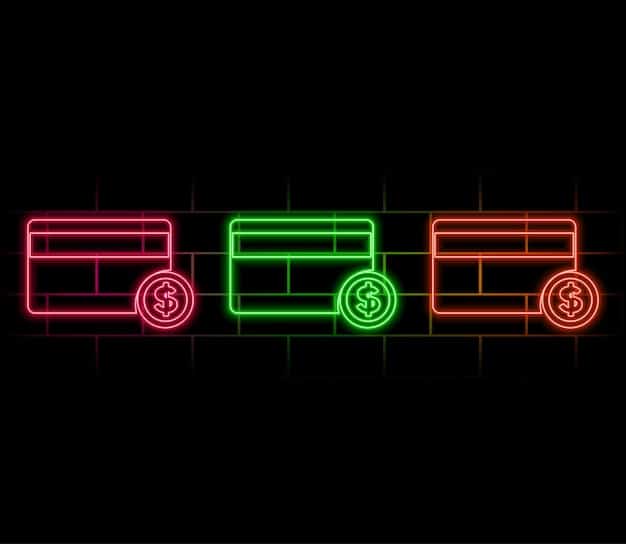Automate Credit Card Rewards: Maximize Points in 2025

Mastering your credit card rewards strategy for 2025 transcends manual tracking, as automating your points accumulation and redemption is crucial to ensuring you don’t leave points on the table and maximize financial benefits without constant oversight.
In the dynamic world of personal finance, one area often overlooked, yet ripe for significant gains, is the strategic management of credit card rewards. For many, the allure of points, miles, or cashback remains just that – an allure, rarely fully realized due to complexity, time constraints, or a simple lack of consistent effort. This year, it’s time to fundamentally shift that paradigm. The goal is to ensure you don’t leave points on the table: automate your credit card rewards strategy in 2025, transforming a potential hassle into a seamless, wealth-building machine.
The Evolving Landscape of Credit Card Rewards in 2025
The credit card rewards ecosystem is far from static. Each year brings new cards, new redemption options, and shifting bonus categories, making it a perpetually moving target for the average consumer. For 2025, we’re seeing an acceleration of trends aimed at personalization and digital integration, placing a premium on smart, automated systems.
Understanding these shifts is the first step toward effective automation. Issuers are increasingly leveraging AI to tailor offers, making it more challenging to optimize without a clear strategy. The traditional “set it and forget it” approach is becoming less effective, replaced by a need for “set it and periodically review it” systems that can adapt to changing terms and new opportunities.
Predicting Key Trends
Several key trends are shaping the rewards landscape in 2025. Recognizing these can help tailor your automation strategy proactively:
- Hyper-Personalized Offers: Banks are using advanced analytics to offer highly specific bonuses based on your spending habits, requiring dynamic tracking to capitalize fully.
- Sustainability Incentives: A growing number of cards are linking rewards to eco-friendly spending or offering carbon footprint tracking, appealing to a segment of consumers looking for conscious spending.
- Enhanced Digital Wallet Integration: Expect deeper integration with payment apps and digital wallets, potentially offering additional bonuses or streamlined redemption paths.
- Tiered Rewards Structures: More complex systems where higher spending or specific merchant categories unlock greater multipliers, necessitating precise card usage.
Staying informed about these macro trends allows for an automation strategy that isn’t just reactive but forward-thinking. It’s about anticipating where the value will be and positioning yourself to capture it, rather than chasing opportunities after they’ve peaked.
Moreover, the rise of fintech innovations continues to influence how points are earned and spent. New platforms emerge that promise to simplify tracking and redemption, yet not all deliver on their promises. Discerning which tools genuinely add value, and which merely add noise, is crucial for building a robust, automated system. The discerning consumer knows that true value lies in efficiency and maximum yield, not just myriad options.
Establish Your Financial Goals and Spending Habits
Before any automation can begin, a fundamental understanding of your personal finances is paramount. What are your specific financial goals? Are you saving for a dream vacation, aiming to reduce everyday expenses, or building a nest egg for the future? Your objectives should dictate your rewards strategy, as different cards excel in different areas.
Equally important is a meticulous analysis of your spending habits. Where does your money go each month? Do you spend heavily on groceries, dining out, travel, or online shopping? The answers to these questions will reveal natural spending patterns that can be aligned with specific card bonus categories, unlocking maximum earning potential.
Categorizing Your Spending
Begin by categorizing your expenses over a period, perhaps three to six months. Most banking apps and personal finance software can do this automatically. Look for consistent patterns:
- Are you typically spending more on essential bills or discretionary purchases?
- Which categories consistently account for the largest portions of your budget?
- Are there any predictable large purchases you make annually, like insurance premiums or vehicle maintenance?
This granular insight forms the bedrock of a targeted rewards strategy. For instance, if you find that a significant portion of your budget goes towards groceries and gas, prioritizing cards that offer accelerated rewards in these categories becomes a clear objective. Conversely, if travel is your primary goal, focusing on airline miles or hotel points programs is more logical.
Identifying your spending habits isn’t just about finding where you spend; it’s also about identifying where you could spend smarter. Sometimes, a slight shift in a preferred vendor or payment method can unlock substantially more rewards. This analytical phase sets the stage for choosing the right cards and, subsequently, the right automation tools.
Without this foundational self-assessment, any automation attempt will be akin to building a house on sand. The value of automation lies in its ability to execute a well-defined strategy, not to create one out of thin air. Take the time to genuinely understand your financial flow; it’s the most profitable pre-automation step you can take.
Choosing the Right Credit Cards for Automation
The market is saturated with credit card offers, each boasting unique benefits. The key to automation isn’t accumulating every card, but rather curating a portfolio that aligns perfectly with your established spending habits and financial goals. This is where strategic selection truly shines, transforming overwhelming choice into a focused arsenal for points maximization.
Look beyond the attractive sign-up bonuses initially; while valuable, they are one-time gains. Focus on the long-term earning potential, especially the bonus categories and the flexibility of redemption options. A card that offers 5% back on categories you rarely spend in is far less valuable than one offering 2% on your consistent large expenses.
Diversifying Your Card Portfolio
A well-rounded portfolio typically includes a mix of cards:
- Everyday Spender: A card with a solid flat-rate reward on all purchases (e.g., 1.5% or 2% cashback or equivalent points), useful for categories not covered by other bonus rates.
- Category Bonus Cards: Cards that offer elevated rewards in specific, rotating, or fixed categories (e.g., 3-5% on groceries, dining, gas, or travel). These are often the workhorses of a rewards strategy.
- Travel-Specific Cards: If travel is a priority, cards linked to specific airlines or hotel chains, or general travel cards with flexible points programs, are essential. These often come with valuable perks like lounge access or free checked bags.
- No Annual Fee Options: Consider at least one no annual fee card to maintain a long credit history without recurring costs, even if it’s not a primary spending card.
The ideal scenario involves having cards that complement each other, covering all your major spending categories with optimized reward rates. For instance, you might use one card for groceries, another for dining, and a third for all other expenses. The complexity should be manageable, allowing for eventual automation without constant manual intervention.

Furthermore, consider the redemption value of points. Some points are fixed at 1 cent per point, while others, particularly travel points, can yield significantly higher value when redeemed strategically. Automation means ensuring these points are not just earned efficiently but also readily available for high-value redemptions.
Finally, always assess the annual fees. A card with a high annual fee might be worth it if the rewards and perks far outweigh the cost, but for true automation, you want to be certain you’re extracting maximum value without unnecessary expenditures. The right card selection is the engine of your automated rewards machine.
Leveraging Technology: The Automation Toolkit
Once you’ve aligned your goals, spending, and card portfolio, the next crucial step is to arm yourself with the right technology. Automation in credit card rewards is increasingly powered by sophisticated apps, browser extensions, and financial management platforms. These tools are designed to reduce manual effort, track spending, optimize card usage, and even suggest redemption strategies.
The goal is to shift from reactive, manual optimization to proactive, systemic efficiency. This toolkit aims to do the heavy lifting, from reminding you about rotating bonus categories to alerting you when you’ve hit a spending threshold for a sign-up bonus.
Essential Automation Tools for 2025
- Reward Tracking Apps: Platforms like MaxRewards, AwardWallet, or various bank-specific apps can aggregate all your card accounts, track points balances, and even alert you to expiring points or favorable redemption opportunities. Many integrate directly with issuer APIs for real-time data.
- Browser Extensions: Tools like CardPointers can automatically suggest the best card to use for online purchases based on current bonus categories, seamlessly integrated into your shopping experience.
- Personal Finance Management Software: Broader platforms such as Mint, Personal Capital, or Tiller Money can provide an overarching view of your finances, including spending categories, which can then inform your credit card optimization. While not direct ‘automation’ for rewards, they provide the data needed to continually refine your strategy.
- Automated Bill Pay: Crucial for ensuring you never miss a payment and incur fees or late interest, which would negate any rewards earned. Set up automatic payments for minimums or full statements directly with your card issuers.
- Loyalty Program Integrations: Some apps now offer direct integration with airline and hotel loyalty programs, allowing for a consolidated view of all your potential travel redemptions.

Beyond these, consider setting up automated alerts from your credit card issuers themselves. Many provide email or text notifications for large purchases, balance thresholds, or upcoming bill due dates. These act as an additional layer of security and management, ensuring no surprise fees or missed opportunities.
The beauty of this toolkit lies in its ability to provide centralized control and insights. Instead of logging into multiple bank accounts, you get a holistic view of your reward potential. This allows for data-driven decisions and minimizes the chance of “leaving points on the table” simply because the information wasn’t readily accessible or digestible.
While these tools add a layer of convenience, remember that they are just tools. They require initial setup and periodic review to ensure they continue to align with your evolving financial situation and the ever-changing rewards landscape. The human element remains vital, albeit with significantly less manual effort.
Setting Up Smart Spending Rules and Prompts
Full automation goes beyond just choosing the right cards and tools; it involves establishing intelligent spending rules and proactive prompts that guide your behavior without constant manual thought. This is the strategic layer that ensures you’re consistently using the optimal card for every purchase, maximizing every point and cashback opportunity.
This phase is about creating habits that leverage your chosen card portfolio. It’s about making the “right” financial decision almost automatic, freeing up mental bandwidth for other priorities. Smart spending rules are your personal algorithms for financial efficiency.
Practical Automation Strategies
- Default Card for Each Category: Assign a specific credit card as the “go-to” for each major spending category (e.g., Card A for groceries, Card B for dining, Card C for online shopping). Make this physically apparent, perhaps by organizing your wallet or digital wallet with these assignments in mind.
- Digital Wallet Optimization: In apps like Apple Pay or Google Pay, set your default cards for specific merchants or types of transactions. For instance, link your grocery bonus card to the grocery store’s loyalty app within your digital wallet.
- Recurring Bill Automation: Ensure all recurring bills (utilities, subscriptions, streaming services) are paid with the card that offers the best rewards for those types of expenses, or at least a card that offers a flat rate without foreign transaction fees if applicable.
- Calendar Reminders for Rotating Categories: If you have cards with rotating bonus categories (like Chase Freedom Flex or Discover It), set calendar reminders (e.g., Google Calendar, Outlook) for the start of each new quarter to activate the new categories and adjust your spending strategy accordingly.
- Threshold Alerts: For cards with spending thresholds for sign-up bonuses or tier upgrades, set up alerts in your tracking app or even a personal note to yourself when you’re nearing the deadline or the required spend.
Beyond individual purchases, consider your larger financial flows. If you have significant annual expenses, schedule them to fall within a period when a particular card offers elevated rewards for that category, if possible. This requires foresight but can lead to substantial gains.
The key here is habit formation. Initially, it might feel like more effort to set these rules, but over time, they become second nature. You’re effectively programming yourself and your digital tools to make optimal financial decisions on your behalf. This significantly reduces the chances of “leaving points on the table” due to oversight or forgetfulness, allowing your rewards to accumulate with minimal conscious effort.
Monitoring and Adjusting Your Automated Strategy
Even the most meticulously planned automated system requires regular monitoring and periodic adjustments. The financial landscape, your spending habits, and credit card offers are dynamic, rendering a “set it and forget it” approach inefficient in the long run. True optimization involves a conscious cycle of review and refinement.
Think of it as tending to a garden. You plant the seeds (set up automation), but you still need to water (monitor) and prune (adjust) to ensure a flourishing yield. Without this vigilance, your automated system can quickly become outdated, costing you potential rewards.
When and What to Review
- Quarterly Review of Bonus Categories: If you have cards with rotating bonus categories, mark your calendar to check and activate new categories at the start of each quarter. Adjust your default spending plans accordingly.
- Annual Card Portfolio Review: Once a year, preferably before any annual fees are due, assess each card in your portfolio. Is it still providing value commensurate with its fee? Are there new cards on the market that would better suit your current spending or goals? This is when you consider product changes or cancellations.
- Spending Habit Check-in: Life changes. A new job, a move, or a lifestyle shift can alter your spending patterns. Periodically review your actual expenditures (e.g., every 6-12 months) to ensure your card choices and automated rules still align with where your money genuinely goes.
- Redemption Value Assessment: With points and miles, redemption values can fluctuate. Regularly check the value you’re getting from your redemptions. Are your travel points still yielding maximum value for flights, or has a shift in airline loyalty programs made cash back more appealing for now?
- New Card Opportunities: Keep an eye out for compelling sign-up bonuses if you’re in a position to responsibly take on new credit. Remember to factor in credit score impact and spending requirements.
This monitoring doesn’t need to be burdensome. Dedicate a specific hour each quarter for a comprehensive review. Use your chosen automation tools to provide quick snapshots of your points accumulation and spending breakdowns. This routine check-up ensures that your automated system remains cutting-edge and continues to deliver maximum value, preventing you from “leaving points on the table” due to outdated strategies.
The objective is to strike a balance between automation and active management. The automation handles the day-to-day execution, while your periodic reviews ensure the strategy itself remains optimal. This blended approach is the most effective way to maximize your credit card rewards in 2025 and beyond.
Redeeming Points Strategically and Avoiding Pitfalls
Earning points is only half the battle; the true art lies in redeeming them effectively. Many consumers accumulate vast quantities of points without a clear redemption strategy, often leading to devalued rewards or missed opportunities. True financial acumen means maximizing the value of every point earned, ensuring you’re not just collecting, but truly capitalizing.
Automation in redemption isn’t about setting up automatic point redemptions (which is often ill-advised as it can lead to low-value exchanges). Instead, it’s about having a clear, pre-defined plan for how and when you’ll use your points, informed by smart tracking and alerts.
Optimizing Your Redemptions
- Define Your Redemption Goals: Before you even start earning, know what you’re working towards. Is it a specific dream vacation? Offsetting everyday expenses? High-value gift cards? Different points programs excel for different goals.
- Understand Point Valuation: Not all points are created equal. Travel points (especially transferable ones like Amex Membership Rewards, Chase Ultimate Rewards, or Citi ThankYou Points) often yield the highest value when transferred to airline or hotel partners. Cashback is usually a fixed 1 cent per point. Understand the average value and aim for redemptions above that.
- Avoid Expedited Redemptions: Often, the most convenient redemption options (e.g., redeeming points for a statement credit at 1 cent per point when they could be worth 2 cents for travel) are the least valuable. Patience often pays off.
- Monitor Transfer Bonuses: Airlines and hotels occasionally offer transfer bonuses (e.g., 25% more miles when you transfer points from a credit card). These are prime opportunities to maximize value. Set up alerts for these occurrences.
- Strategic Travel Booking: For travel, learn about award charts and peak/off-peak pricing. Booking well in advance or during sales can significantly stretch your points.
A common pitfall is letting points expire. While less common with major issuer points, some airline or hotel points can have expiration dates tied to inactivity. Your rewards tracking app should alert you to these, but also ensure you have a plan to use just enough points or earn enough to reset activity requirements.
Another pitfall is accumulating points on cards with high annual fees without fully utilizing the benefits. If you’re paying a $95 annual fee for a card primarily for its dining rewards, but now primarily cook at home, rethink its place in your wallet. The fee itself is a point drain if not offset by benefits.
Finally, be wary of “point harvesting” without a purpose. Accumulating points for the sake of it can lead to analysis paralysis or simply forgetting about them. Your automated strategy should culminate in efficient, valuable redemptions that directly contribute to your financial well-being or lifestyle goals, ensuring no point is ever truly “left on the table.”
| Key Principle | Brief Description |
|---|---|
| 🎯 Goal Alignment | Match your card choices and automation to your specific financial goals (e.g., travel, cashback). |
| ⚙️ Tech Leverage | Utilize apps and extensions to track rewards, optimize spending, and manage accounts efficiently. |
| 🔄 Dynamic Review | Regularly review spending patterns, card offers, and redemption values to maintain optimization. |
| 💰 Smart Redemption | Plan point redemptions strategically to maximize value, avoiding common pitfalls and maximizing benefits. |
Frequently Asked Questions
▼
Automating credit card rewards means setting up systems and habits that minimize manual effort in optimizing point accumulation and redemption. This involves using apps for tracking, setting up smart spending rules, and regularly reviewing your strategy to ensure you’re always using the best card for each purchase and redeeming points most effectively. It’s about proactive management rather than constant reactive decision-making.
▼
To identify your best cards, first analyze your detailed spending habits over several months to understand where your money goes. Then, compare these categories against your cards’ bonus multipliers. Prioritize cards that offer elevated rewards in your most frequent spending areas, and consider a strong flat-rate card for all other purchases. The goal is a curated portfolio that covers your primary expenses optimally.
▼
Yes, several apps excel at reward tracking. Popular choices include MaxRewards, which aggregates points balances and suggests optimal card usage; AwardWallet, ideal for tracking loyalty program balances, and CardPointers, a browser extension that offers real-time card recommendations for online purchases. Many individual credit card issuers also offer robust apps that provide detailed insights into your earned rewards and spending.
▼
Ideally, you should review your automated rewards strategy quarterly and annually. Quarterly reviews are crucial for updating rotating bonus categories and assessing any minor shifts in spending. An annual review should be more comprehensive, evaluating the overall value of your card portfolio, considering annual fees, and checking for new card offers or significant changes in your financial goals or spending habits.
▼
Common pitfalls include accumulating points without a clear redemption goal, letting points expire due to inactivity, and paying high annual fees for cards whose benefits you no longer fully utilize. Also, automatically redeeming points at low values (e.g., for statement credits when higher-value travel redemptions are available) is a frequent mistake. Strategic, informed redemption is just as critical as efficient earning.
Conclusion
In a world where financial efficiency is increasingly paramount, letting credit card points and rewards go unused is akin to leaving money on the table. For 2025, the strategic shift towards automation isn’t merely a convenience; it’s a necessity for those serious about maximizing their financial potential without being overwhelmed by complexity. By meticulously aligning your financial goals with your spending habits, curating a precise credit card portfolio, leveraging cutting-edge technology, and establishing intelligent spending rules, you can transform a once-manual chore into a seamless, wealth-building process. Remember, the journey doesn’t end with setup; consistent monitoring and strategic redemption are the final, crucial steps that ensure every point earned contributes meaningfully to your financial well-being. Embrace automation, and confidently navigate the rewards landscape, knowing you’re truly optimizing every dollar spent.





